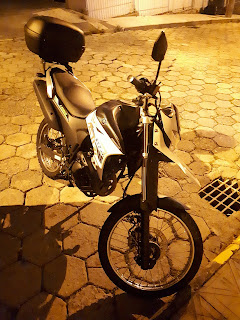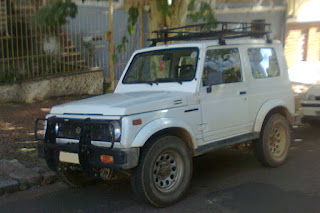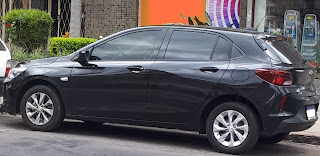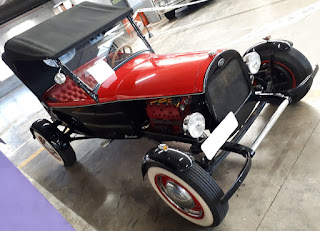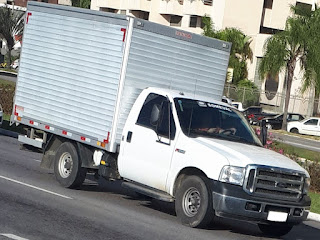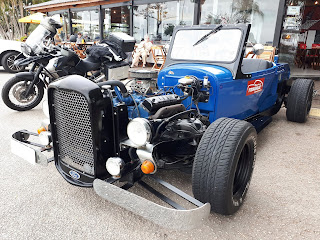Sunday, March 29, 2020
Beetle-engined Simca 8
Friday, March 27, 2020
5 cars that I would eventually consider retrofitting a single-cylinder 250cc motorcycle engine
At a first glance, it may seem that a 250cc single-cylinder out of some motorcycle developed for an emerging market, such as the Yamaha XTZ 250 Lander or the Honda CB Twister, could be unsuitable to a car. Sure it may not be a perfect one-size-fits-all approach, but under some circumstances it can be a reasonable and cost-effective option. At least 5 cars could actually be quite interesting with one of such engines in case their original powerplants become damaged beyond repair.
1 - Volkswagen Beetle: even though its basic engine layout is considered nearly indestructible, and has remained nearly unchanged through its entire production run, nowadays the cost of replacement parts skyrocketed due to all the posers who just want an ancient car for showing-off, not to mention all the witch-hunting against internal-combustion engines that also tends to target ancient vehicles. So a small motorcycle engine, which may often provide performance levels comparable to an early 1200 Beetle engine, may cater both to those who still rely on one as a daily commuter or even a handful of collectors who would be forced to upgrade to an engine certified on a more strict emission regulation. On a sidenote, the lower weight of a 250cc thumper might open way to move the battery from under the rear seat to the engine bay, keeping the weight bias closer to stock while also decreasing the risk of a short-circuit which could happen when some metallic component of the seat structure touches the poles of the battery;
2 - Asia Motors Towner: the Korean microvan which was a licensed derivative of the Daihatsu HiJet used to be quite popular on some export markets such as my homeland Brazil, where its imports were finished in '99 due to the bankruptcy of Asia Motors, even though Kia resumed its production for a while. Replacements became scarce, rendering the model subjected to many adaptations in order to enable an extended useful life. With so many of the engines usually retrofitted to them being heavier than the stock 0.8L 3-cylinder, presumably a 250cc single-cylinder out of a motorcycle can decrease the impact over the weight bias. It may also be possible to resort to an aftermarket reversing gear usually fitted to motorcycles converted into tricycles instead of working around to keep both the transmission integrated to the replacement engine and the stock one from the vehicle undergoing the repower, due to the front-mid engine and rear-wheel drive layout;
3 - Suzuki Samurai: the small Jeep-like rig has actually been available with many different engines, including some naturally-aspirated ones within the 550cc displacement range formerly enforced for the Kei cars in Japan that could be seen as somewhat underpowered, so a modern 250cc motorcycle engine is not so likely to become effectively unsuitable for a swap. Due to the 4-wheel drive, even if the motorcycle engine could be coupled to a reversing gear, it would require the output delivered to the transfer case instead of directly to the rear axle. That said, unless it also gets converted to 2-wheel drive only;
4 - Renault Dauphine/Gordini: not so widespread as the Beetle, but with a similar rear-wheel drive and rear longitudinally-mounted engine configuration, it could eventually fare better than the Beetle with a 250cc repowering. Its stock water-cooled 0.85L Ventoux engine is also harder to find parts, so it makes even more sense to consider a swap, even though it wouldn't make so much sense to do so if the vehicle is in a mint condition, also considering the possibility to fit other Renault engines;
5 - Gurgel Supermini: this Brazilian attempt to replace the Beetle resorted to a front-mounted 0.8L water-cooled flat-twin engine and rear-wheel drive, resorting to a 50-50 weight bias transferring most of the weight closer to the rear axle while loaded either partially or fully, increasing its traction even in harsh terrain conditions without the need for 4-wheel drive. Replacement parts for its stock engine are getting quite scarce, especially the crankshaft, even though it's been reported that half a Beetle crankshaft can be repurposed to serve it, and then an engine swap becomes a nearly obvious approach. However, most of the engines retrofitted are heavier and longer, moving the weight bias to become heavier at the front axle. Since a 250cc motorcycle engine tends to be lighter, it may decrease the side-effect observed in other engine swaps more prevalent in this model.
1 - Volkswagen Beetle: even though its basic engine layout is considered nearly indestructible, and has remained nearly unchanged through its entire production run, nowadays the cost of replacement parts skyrocketed due to all the posers who just want an ancient car for showing-off, not to mention all the witch-hunting against internal-combustion engines that also tends to target ancient vehicles. So a small motorcycle engine, which may often provide performance levels comparable to an early 1200 Beetle engine, may cater both to those who still rely on one as a daily commuter or even a handful of collectors who would be forced to upgrade to an engine certified on a more strict emission regulation. On a sidenote, the lower weight of a 250cc thumper might open way to move the battery from under the rear seat to the engine bay, keeping the weight bias closer to stock while also decreasing the risk of a short-circuit which could happen when some metallic component of the seat structure touches the poles of the battery;
2 - Asia Motors Towner: the Korean microvan which was a licensed derivative of the Daihatsu HiJet used to be quite popular on some export markets such as my homeland Brazil, where its imports were finished in '99 due to the bankruptcy of Asia Motors, even though Kia resumed its production for a while. Replacements became scarce, rendering the model subjected to many adaptations in order to enable an extended useful life. With so many of the engines usually retrofitted to them being heavier than the stock 0.8L 3-cylinder, presumably a 250cc single-cylinder out of a motorcycle can decrease the impact over the weight bias. It may also be possible to resort to an aftermarket reversing gear usually fitted to motorcycles converted into tricycles instead of working around to keep both the transmission integrated to the replacement engine and the stock one from the vehicle undergoing the repower, due to the front-mid engine and rear-wheel drive layout;
3 - Suzuki Samurai: the small Jeep-like rig has actually been available with many different engines, including some naturally-aspirated ones within the 550cc displacement range formerly enforced for the Kei cars in Japan that could be seen as somewhat underpowered, so a modern 250cc motorcycle engine is not so likely to become effectively unsuitable for a swap. Due to the 4-wheel drive, even if the motorcycle engine could be coupled to a reversing gear, it would require the output delivered to the transfer case instead of directly to the rear axle. That said, unless it also gets converted to 2-wheel drive only;
4 - Renault Dauphine/Gordini: not so widespread as the Beetle, but with a similar rear-wheel drive and rear longitudinally-mounted engine configuration, it could eventually fare better than the Beetle with a 250cc repowering. Its stock water-cooled 0.85L Ventoux engine is also harder to find parts, so it makes even more sense to consider a swap, even though it wouldn't make so much sense to do so if the vehicle is in a mint condition, also considering the possibility to fit other Renault engines;
5 - Gurgel Supermini: this Brazilian attempt to replace the Beetle resorted to a front-mounted 0.8L water-cooled flat-twin engine and rear-wheel drive, resorting to a 50-50 weight bias transferring most of the weight closer to the rear axle while loaded either partially or fully, increasing its traction even in harsh terrain conditions without the need for 4-wheel drive. Replacement parts for its stock engine are getting quite scarce, especially the crankshaft, even though it's been reported that half a Beetle crankshaft can be repurposed to serve it, and then an engine swap becomes a nearly obvious approach. However, most of the engines retrofitted are heavier and longer, moving the weight bias to become heavier at the front axle. Since a 250cc motorcycle engine tends to be lighter, it may decrease the side-effect observed in other engine swaps more prevalent in this model.
Friday, March 20, 2020
Why is it pointless to overlook Diesel in entry-level models and emerging markets?
The release of the 2nd generation of the Chevrolet Onix, not anymore as a Brazilian makeshift with a limited availability through few regional export markets in order to get a much greater engineering input from the Chinese SAIC-GM joint-venture, could've been turned into an opportunity for GM to recover its global presence not only in the LHD emerging markets which could be easily served with either Chinese, Brazilian or Mexican models. However, besides the lack of a right-hand drive layout option which could cater to some markets where GM recently retreated such as India, South Africa, Thailand and Australia, it's also worth to notice the absence of at least one turbodiesel engine which certainly has its appeal among customers with the most diverse needs and subjective preferences. Even though such option could be regarded as too expensive for an entry-level compact sedan meant for emerging markets where the retail price is extremely relevant, there are other factors rendering such claim pointless.
Initially released exclusively with turbocharged gasoline-powered engines, featuring direct injection in China and port-injection in Brazil where naturally-aspirated versions would later become available for the local market in the 1.0L displacement and a 1.2L variant exclusive for regional export, simply the presence of the turbocharger is enough to increase manufacturing cost to a point which could be seen as an excuse to prefer a naturally-aspirated counterpart with a larger displacement if production cost was the major issue and had displacement-biased tax structures been negligible. Turbocharging and fitting direct injection to spark-ignited engines has led their cost to increase to a point which can be seen as favorable to turbodiesels in a comparison based on cost alone, not to mention other issues related to emissions compliance. Nitrogen oxides (NOx) and particulate matter used to be considered an Achille's heel of Diesel engines, related not only to the fuel but mostly to the thermodynamic cycle which relies on compression ignition, but the recent widespread of direct injection on spark-ignited engines also increased the conditions of high temperature and pressure which favor the formation of NOx and particulate matter due to the less effective cooling of the air intake charge and incomplete vaporizing of the fuel.
Besides the sedan bodystyle which is the only one available in China and Mexico, a hatchback had to be developed for Brazil, where Diesel cars are mostly forbidden. However, if any turbodiesel version would ever become manufactured at least for export, the presumable impact due to the fitment of any emissions-related device such as the SCR system with the corresponding AdBlue tank could certainly be blamed for an overall worse impact on the trunk capacity compared to a sedan, even though some factors such as the focus on some lower gap on the automotive market might render more favorable conditions to other approaches such as resorting to an LNT (Lean NOx Trap) catalyst which is easier to implement with small-displacement engines and modest power ratings suitable for an economy car. Getting rid of the need for AdBlue is still possible to achieve in a cost-effective manner, and it's also important to remind the increasing usage of direct injection on gasoline engines has led a particulate filter analogue to the DPF to become required in order to keep up to stricter emissions regulations, and any enrichment to the air/fuel ratio which could be an easy approach to keep NOx under control would increase the particulate matter, thus an LNT also becomes important in order to address this issue and the competition between spark ignition and its turbodiesel counterparts remains levelled. The absence of direct injection in the Brazilian versions of the Chevrolet Onix even with the Turbo engine, which could be considered cost-effective not only for port-injection being inherently cheaper but also for not requiring LNT and GPF/OPF (Gasoline Particle Filter/Otto Particle Filter), still has its downsides most noticeably in the turbocharged versions due to the increased fuel consumption and requirement for Premium gasoline in order to prevent knock/ping which can lead to catastrophic engine failure and some even more dangerous situations such as caughting fire which had occurred to some of the earliest of the Brazilian Chevrolet Onix Plus under some extreme environmental conditions.
Even though the narrowing of the gap between emission regulations in the developed countries and the emerging markets could make it seem less cost-effective to keep the turbodiesel option for entry-level due to the side-effects of a lower quality standard of Diesel fuel to the modern emissions-control devices, the increasing complexity of gasoline-powered (and flexfuel) engines doesn't justify all this overlooking of Diesel in entry-level models throughout the world and even more noticeably in the emerging markets. Even though some countries still enforce outdated emission standards which could keep it more comfortable to avoid sophisticated systems such as the SCR and DPF, also decreasing the risk of damage not only to the aftertreatment system but also to the engine itself while using some lower-grade Diesel fuel, others which are now closer to the European regulations could still get them as a cost-effective option. So, even though it may seem comfortable at first to simply rely on spark ignition and eventually go flexfuel like it's done in Brazil, it's pointless to overlook Diesel.
Initially released exclusively with turbocharged gasoline-powered engines, featuring direct injection in China and port-injection in Brazil where naturally-aspirated versions would later become available for the local market in the 1.0L displacement and a 1.2L variant exclusive for regional export, simply the presence of the turbocharger is enough to increase manufacturing cost to a point which could be seen as an excuse to prefer a naturally-aspirated counterpart with a larger displacement if production cost was the major issue and had displacement-biased tax structures been negligible. Turbocharging and fitting direct injection to spark-ignited engines has led their cost to increase to a point which can be seen as favorable to turbodiesels in a comparison based on cost alone, not to mention other issues related to emissions compliance. Nitrogen oxides (NOx) and particulate matter used to be considered an Achille's heel of Diesel engines, related not only to the fuel but mostly to the thermodynamic cycle which relies on compression ignition, but the recent widespread of direct injection on spark-ignited engines also increased the conditions of high temperature and pressure which favor the formation of NOx and particulate matter due to the less effective cooling of the air intake charge and incomplete vaporizing of the fuel.
Besides the sedan bodystyle which is the only one available in China and Mexico, a hatchback had to be developed for Brazil, where Diesel cars are mostly forbidden. However, if any turbodiesel version would ever become manufactured at least for export, the presumable impact due to the fitment of any emissions-related device such as the SCR system with the corresponding AdBlue tank could certainly be blamed for an overall worse impact on the trunk capacity compared to a sedan, even though some factors such as the focus on some lower gap on the automotive market might render more favorable conditions to other approaches such as resorting to an LNT (Lean NOx Trap) catalyst which is easier to implement with small-displacement engines and modest power ratings suitable for an economy car. Getting rid of the need for AdBlue is still possible to achieve in a cost-effective manner, and it's also important to remind the increasing usage of direct injection on gasoline engines has led a particulate filter analogue to the DPF to become required in order to keep up to stricter emissions regulations, and any enrichment to the air/fuel ratio which could be an easy approach to keep NOx under control would increase the particulate matter, thus an LNT also becomes important in order to address this issue and the competition between spark ignition and its turbodiesel counterparts remains levelled. The absence of direct injection in the Brazilian versions of the Chevrolet Onix even with the Turbo engine, which could be considered cost-effective not only for port-injection being inherently cheaper but also for not requiring LNT and GPF/OPF (Gasoline Particle Filter/Otto Particle Filter), still has its downsides most noticeably in the turbocharged versions due to the increased fuel consumption and requirement for Premium gasoline in order to prevent knock/ping which can lead to catastrophic engine failure and some even more dangerous situations such as caughting fire which had occurred to some of the earliest of the Brazilian Chevrolet Onix Plus under some extreme environmental conditions.
Even though the narrowing of the gap between emission regulations in the developed countries and the emerging markets could make it seem less cost-effective to keep the turbodiesel option for entry-level due to the side-effects of a lower quality standard of Diesel fuel to the modern emissions-control devices, the increasing complexity of gasoline-powered (and flexfuel) engines doesn't justify all this overlooking of Diesel in entry-level models throughout the world and even more noticeably in the emerging markets. Even though some countries still enforce outdated emission standards which could keep it more comfortable to avoid sophisticated systems such as the SCR and DPF, also decreasing the risk of damage not only to the aftertreatment system but also to the engine itself while using some lower-grade Diesel fuel, others which are now closer to the European regulations could still get them as a cost-effective option. So, even though it may seem comfortable at first to simply rely on spark ignition and eventually go flexfuel like it's done in Brazil, it's pointless to overlook Diesel.
Thursday, March 19, 2020
Why could a 4-cylinder high-speed turbodiesel be a good alternative to a V8 in hot-rods?
Even though the hot-rod culture is more widely associated to gasoline-powered engines such as the Ford Flathead V8, which could be sourced not only from passenger cars and light-duty trucks but also from medium-duty trucks considering all that "there is no replacement for displacement" philosophy, obviously this is not the only possible approach. Considering the consolidation of Diesel engines as the favorite option among most commercial operators, including the retrofit into older trucks fitted originally with a gasser V8, it could be easy to presume the viability for a similar phenomenon to reach the hot-rod enthusiasts too.
Even though the preference for V8 gassers remains strong in modern hot-rodding, the availability of 4-cylinder high-speed turbodiesel engines being easier on most markets outside the United States and Canada could lead to an increasing interest on those, not to mention the hot-rod scene originating in a counterculture movement which could be related to the recently-widespread political targetting of both large-displacement engines and turbodiesels in general as an environmental threat. Sure the power ratings of most 4-cyl turbodiesels might not be so impressive compared to a stereotypically all-American small-block V8, the torque curve won't render a relatively small turbodiesel so unfavorable compared to a naturally-aspirated V8 or even mildly-boosted through a belt-driven supercharger, even if they feature nearly twice the displacement of their turbodiesel counterpart...
The fitment of the Cummins ISF2.8 engine in the latest versions of the Brazilian Ford F-350 and its regional derivative F-4000 between 2014 and 2019, for which a V8 wouldn't be cost-effective, could seem at first only as a desperate attempt. However, considering fuel prices and consumption while keeping the comparison to the V8 gasoline-powered, resorting to this engine at a regional level was more suitable to the market conditions than going for a V8 PowerStroke turbodiesel fitted to their American counterparts. So, to keep things in proportion, when applied to a truck both a V8 gasser and a 4-cyl turbodiesel might not seem so fancy at all and being considered more for their utilitarian approach, and therefore it's also quite down-to-earth to focus on similarities on other applications, which can include hot-rods too.
Even though the preference for V8 gassers remains strong in modern hot-rodding, the availability of 4-cylinder high-speed turbodiesel engines being easier on most markets outside the United States and Canada could lead to an increasing interest on those, not to mention the hot-rod scene originating in a counterculture movement which could be related to the recently-widespread political targetting of both large-displacement engines and turbodiesels in general as an environmental threat. Sure the power ratings of most 4-cyl turbodiesels might not be so impressive compared to a stereotypically all-American small-block V8, the torque curve won't render a relatively small turbodiesel so unfavorable compared to a naturally-aspirated V8 or even mildly-boosted through a belt-driven supercharger, even if they feature nearly twice the displacement of their turbodiesel counterpart...
The fitment of the Cummins ISF2.8 engine in the latest versions of the Brazilian Ford F-350 and its regional derivative F-4000 between 2014 and 2019, for which a V8 wouldn't be cost-effective, could seem at first only as a desperate attempt. However, considering fuel prices and consumption while keeping the comparison to the V8 gasoline-powered, resorting to this engine at a regional level was more suitable to the market conditions than going for a V8 PowerStroke turbodiesel fitted to their American counterparts. So, to keep things in proportion, when applied to a truck both a V8 gasser and a 4-cyl turbodiesel might not seem so fancy at all and being considered more for their utilitarian approach, and therefore it's also quite down-to-earth to focus on similarities on other applications, which can include hot-rods too.
Subscribe to:
Comments (Atom)




